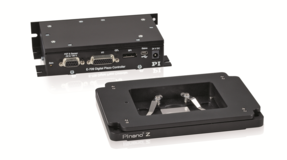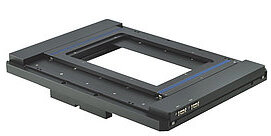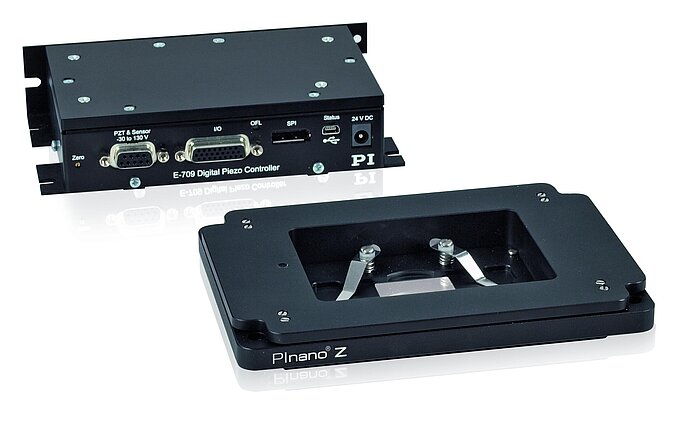Motorized Microscope Stage for High Resolution Microscopy
Low Profile XY Microscope Stages with High-Stability Motors
Microscope stages play a critical role in research, testing, metrology, and production across various fields such as bio-technology, drug discovery, neuroscience, medical technology, and surface metrology. Motorized XY microscope stages need to provide high precision, speed, and a very low-profile formfactor for optimum integration into the microscope, with no interference with the turret and objectives. The more compact the stage design, the easier its application for automating precise positioning tasks within microscopy and metrology. Next to the mechanical features and performance of the microscope stage, the motion controller and software package also play a critical role in its useability.
The U-780 low profile high speed XY microscope stage with linear motors for inverted microscopes is more compact than traditional stepper-motor / servo-motor driven open frame XY stages due to its fully integrated, compact, low profile piezo linear motors.
Self-Locking Ultrasonic Linear Motors, Direct Linear Drive, Direct Metrology Linear Encoders
The self-locking ceramic on ceramic direct-drive liner motors in the U-780 XY scanning microscope stage also provide up to 10X higher positional stability for the following reasons: No holding current is required (no heat dissipation); no leadscrews that heat up due to friction during motion and cause drift cooling down once the motion stops; no lubricant flow in the drive screw causing slow creep. This is why the stage design is superior for long term imaging applications. Linear encoders with 100 nanometer resolution provide direct position measurement with high accuracy. The compact design with minimized mass and inertia provides highly accurate bidirectional speed and position control, as well as very constant velocity, even at very low speeds. The drive system is based on PI's U-164 ultrasonic piezo motor and outperforms the stability, acceleration and settling speed of traditional servo motor direct drives and gear-driven mechanisms. More information on piezo motors is available here.


Applications, Features & Advantages
- Fits Olympus IX2 and Nikon Eclipse Ti inverted microscopes
- High Stability: ideal for Long-Term Microscopy, Imgaging, Image Stitching
- Fast: to 120 mm/second
- Linear Encoders with 100 nanometer resolution
- 135x85 mm Positioning range
- For inverted microscopes, free rotation of turret
- Available Piezo-Z Scanner
- Very constant velocity at 10 µm/second
- Direct-metrology linear encoder
- Accessories: Slides holders, petri dish holder, multi-well plate holders
Controller / Software Support
The microscope stage is delivered with a joystick and a proprietary piezo motor controller optimized to take advantage of the specific motion characteristics of ultrasonic ceramic motors. USB interfacing and a solid software and driver package for seamless integration are part of the package.
Advantages of Motorized Microscope Stages over Manual Stages
Motorized microscope stages offer several advantages over manual stages, which can greatly enhance the efficiency, precision, and convenience of microscopy and related applications. Here's why motorized microscope stages are considered superior:
- Automation and Precision: Motorized stages allow for highly accurate and repeatable positioning, which is crucial for tasks like imaging, scanning, and measurements. Manual stages rely on human intervention, which can introduce inconsistencies and limitations in precision.
- Micrometer-Level Control: Motorized stages provide fine control over positioning, often down to micrometer or even nanometer scales. This level of precision is difficult to achieve consistently with manual adjustments.
- Remote Operation: Motorized stages can be controlled remotely, allowing operators to make adjustments without physically interacting with the stage. This is especially useful when working with delicate samples or in sterile environments where minimizing contamination is crucial.
- Multi-Axis Movement: Motorized stages can move in multiple axes (XY, Z, rotation, tilt, etc.) with synchronized and coordinated motion. This ability is hard to replicate with manual stages, which typically allow movement in one axis at a time.
- Reproducibility: Motorized stages can store and execute predefined positions, paths, or routines with high accuracy. This is beneficial for tasks that require repeated movements or comparisons between different samples or time points.
- Time Efficiency: Motorized stages significantly reduce the time required for sample scanning, mapping, and imaging. Automated routines can be executed much faster than manual adjustments.
- Complex Tasks: Some applications, like 3D imaging, stitching large images, or multi-point measurements, demand complex movements that are best achieved through motorized control.
- Integration with Software: Motorized stages can be easily integrated with software for tasks like image stitching, automated measurements, and data analysis. This allows for a streamlined workflow and efficient data acquisition.
- Reduced Fatigue and User Error: Manual adjustments over extended periods can lead to user fatigue and introduce errors. Motorized stages eliminate these issues, resulting in more consistent and reliable data.
- Long-Term Experiments: For experiments that run over extended periods, motorized stages ensure stability in sample positioning and reduce the risk of disturbances due to human intervention.
While motorized microscope stages have numerous advantages, it's important to note that they are typically more expensive than manual stages and may require additional technical expertise for setup and maintenance. The choice between motorized and manual stages depends on the specific requirements of the application and the available resources.


